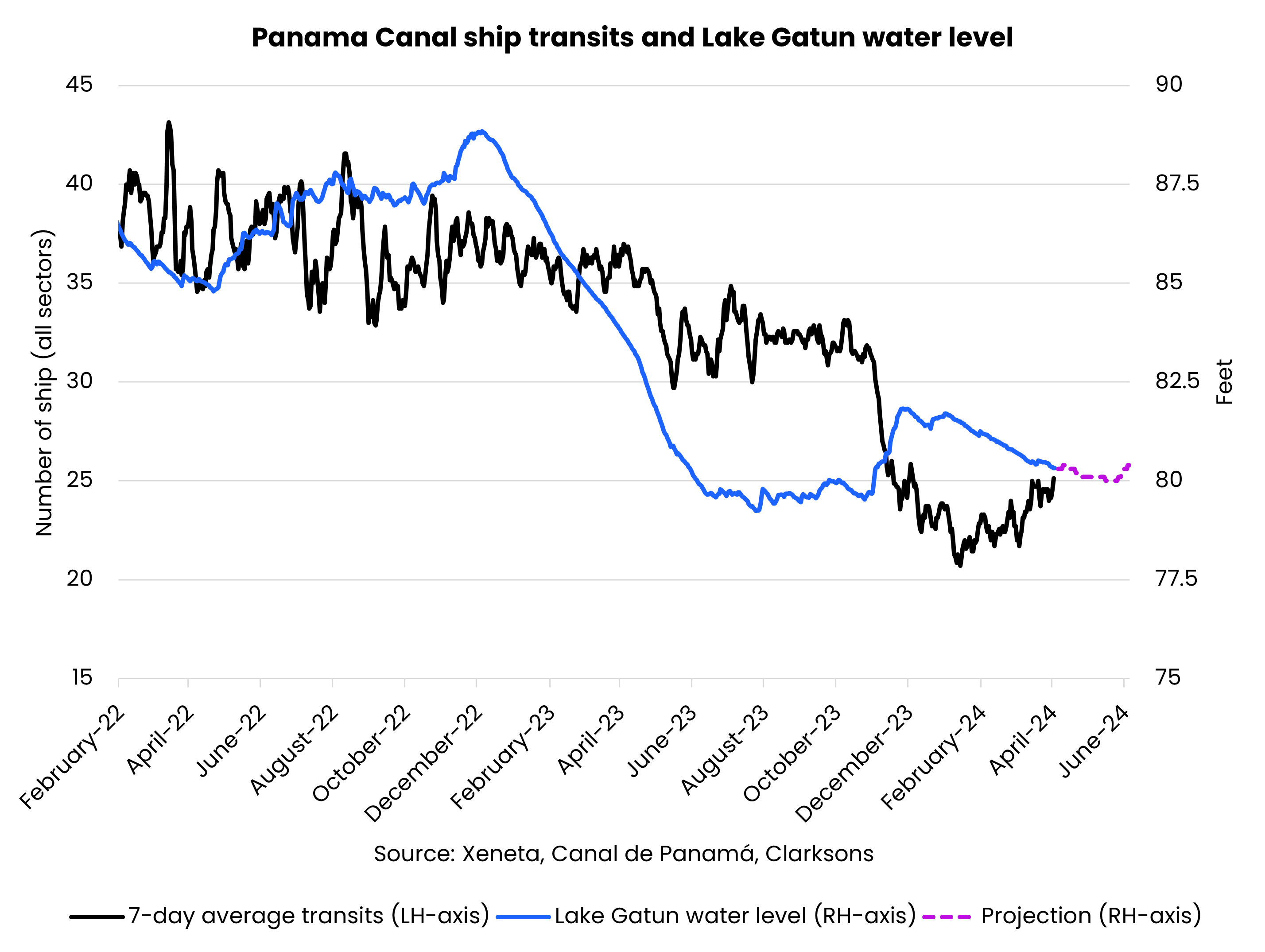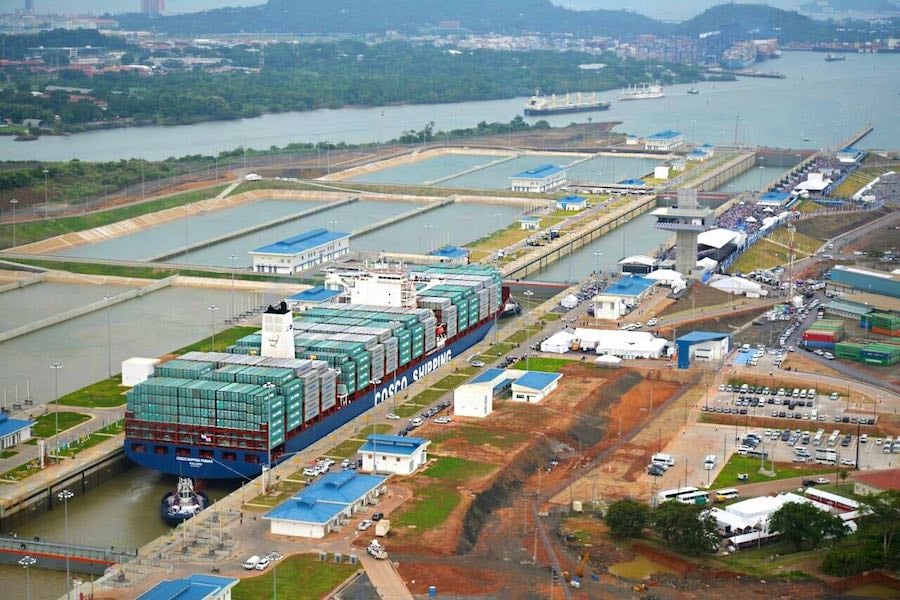Reducing carbon emissions across maritime shipping is in the spotlight this week as the IMO’s Marine Environment Protection Committee (MEPC) meets in London following an exceptional year of climate-related incidents.
MEPC81, taking place from 18-22 March, is expected to build on the IMO’s revised GHG Strategy, which was adopted during MEPC80 last year and includes a common ambition to reach net zero from international shipping by or around 2050.
It also includes a commitment regarding the uptake of alternative zero and near-zero GHG fuels by 2030.
The case for achieving these targets could not be stronger given the clear and present impacts of climate change on maritime supply chains in the past 12 months.
Record-low water levels in Panama Canal
Chief among these climate-related incidents has been drought in the Gatun Lake which serves the Panama Canal. El Nino is the main cause for the drought, but this time it has been even more severe as new climate-related factors add to this traditional weather phenomenon.
Months of reduced rainfall has seen the lowest water levels since the Panama Canal Authority began keeping records in 1965. This has resulted in a reduction in the number of vessels permitted to transit the canal, down from approximately 36 per day under normal conditions to just 22 in January. It has since inched up to 23 in February and 24 in March.
Peter Sand, Xeneta Chief Analyst, said: “Ocean freight carriers have been telling the Panamanian authorities that they spend billions and billions of dollars to transit the canal and they expect a better service.
“You cannot do anything about an El Nino weather event, but there is an argument to be made that there are too few initiatives, taking place too late, to protect the Panama Canal and its existence as an effective and efficient shortcut.”
Major innovation is required
Sand has warned the 2023 drought will continue to impact the Panama Canal throughout 2024 – and possibly become a more regular occurrence in future.
The impact of drought is not only on the number of ships that can transit the canal but also the amount of cargo they can carry. The normal draft restriction in the Neopanamax locks is 50 feet but, due to water levels, currently stands at 44 feet.
He said: “Water levels in the Gatun Lake will be below the required level for the rest of 2024 and you cannot rule out further droughts in years to come, and not only from El Nino.
“This problem will be super difficult to solve, and it may well require the spirit of engineering innovation which saw the Panama Canal come into existence in the first place.
“We have already seen some engineering solutions to protect water levels and ensure water conservation, such as the Neopanamax locks, but it will require further major innovation and it won’t happen overnight.”

Critical waterways around the world are in the grip of drought
Climate-related events are impacting supply chains across the maritime network. For instance, the summer of 2022 saw drought and low water levels in the Rhine, which typically transports more than 300 million tons of goods each year between the North Sea port of Rotterdam and the heart of mainland Europe.
The World Economic Forum has also reported a major jump in the economic damage caused by drought on the world’s maritime trade routes.
2023 saw droughts on major trade waterways including the Yangtze in China and Mississippi in the US, while the Amazon river levels at the port of Manaus in Brazil reached their lowest levels since 1902.
Sand outlined the potential impact of a major drought on inland waterways.
He said: “The Rhine is used for onward transportation of ocean freight containers when they arrive at Rotterdam. If there is severe drought then you may not be able to do this, or at least the containers won’t be able to make it as far along the river into the heart of Europe as they ordinarily would do.
“Whenever ports get clogged up, or they are not working as efficiently as they should do, it can have significant knock-on effects, as we saw with the congestion at US West Coast ports during Covid-19 or when Ever Given got stuck in the sand dunes around the Suez Canal in March 2021.
“You could unload boxes at Rotterdam and transport them as far up the river as the water levels allow before transferring to alternative transportation modes, such as rail or truck. But smaller inland ports don’t usually have the infrastructure to support this.
“All this adds time and delays – and time is always of the essence in shipping.”
Moving the needle on climate change
Coming back to the MEPC81 meeting, is the maritime shipping industry doing enough to protect supply chains and play its part in our collective response to the climate emergency?
Sand said: “The IMO is the only way to move the needle on climate change at a global scale.
“What we can say is that maritime shipping has a plan set in stone and reaching net zero GHG emissions from international shipping by 2050 is a mindblowing target.
“Meanwhile, other industries are pretending nothing is wrong and are burning more and more fuel every year.
“Maritime shipping also has an energy efficiency index to identify and take action against the poorest performers from an emissions point of view. If you are a bad carbon emitter then you need to do something about it, whether that is slow down, de-rate the engine or scrap the ship.”
Data will be key in tackling climate emergency
Sand believes further regulation may be required to achieve the lofty emissions targets – as well as robust data reporting and analysis.
He said: “We talk about the introduction of EU-ETS emissions regulations in Europe but perhaps some sort of global emissions trading scheme is required – or any other way of putting a price tag on carbon emissions.
“Data will be key to supporting the industry on the path to net zero and already the Xeneta platform has EU-ETS surcharge data available for our customers.
“Xeneta also publishes a Carbon Emissions Index (CEI) in partnership with Marine Benchmark to provide insight on the carbon intensity of ocean freight shipping lines and carriers across 48 global trades.
“From an actionable point of view, it allows shippers to choose a carrier to transport their cargo with a proven track record for having a low carbon footprint.
“This data is going to be absolutely vital for companies across the maritime shipping industry, both now and in years to come, because we must all strive to learn and work together to tackle climate change.”






